SoapMakingResource
Member
Hey Everyone! My name is Steve. I’ve been browsing these forums for a long time reading posts and looking at pictures. I just thought I’d finally share some of my own with you all!
I’m working very hard on creating a natural soap colorant database for myself and my fellow soapers. I will be making a ton of batches in the next few months experimenting with the various natural colorants and recording my results to share with you all.
I am looking at how the percentage of infused oil in my batch will affect the color, how adding the botanical to the lye solution will affect the color, how adding the powdered botanical to the soap will affect the color, how my superfat percentage will affect the color, and how the gel phase will affect the color. Yeah… It’s very thorough! Hopefully though, it will be a helpful tool for soap makers who are interested in using natural colorants but don’t know where to start.
I will be taking a ton of pictures and notes and figured I’d might as well share them with you all. I hope it helps in some way!
I just finished the annatto seed portion of the database. Below are the pictures from that tutorial. Enjoy!
The first photo is a picture of all the shades I achieved with annatto seeds using all the different methods. As you can see, you can get a lot of different hues all the way from a bright yellow to dark orange using annatto seeds. I thought this was pretty cool to see them all side by side.
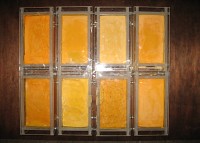
My infusion rate was 4 teaspoons annatto seeds per 8 ounces of olive oil. I created this infusion by placing the seeds and oil in my crock-pot that was set at a low heat and then allowed this combination to simmer for exactly two hours. By the end of the infusion, the oil appeared to have a deep red color, however, the infused oil still produced a strong yellow color when dropped onto a piece of white paper towel.
Here’s a before and after picture of my infusion. You can really see just how much the color changed:
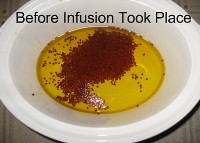
--------------------------------------------------------
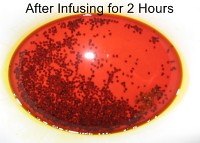
Side by side, you can really see the color difference between the infused oil and non-infused oil. Annatto infused oil is really very pretty!
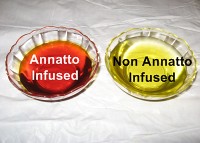
Here’s another pic… This one is of me pouring the infused oil into my soap batch. I just thought this was a pretty cool shot and kind of highlights the beauty of the annatto infused oil. Again, it looks red at first, but even this batch quickly turned yellow/orange once the infused oil was mixed in thoroughly.
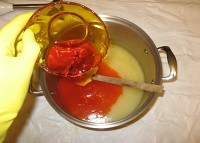
Now for some pics of the final annatto seed soaps…
Below is a picture of my soap batch that had 5% annatto seed infused oil. What does this mean exactly? Let’s say your batch uses 45 ounces of oils total… 5% of 45 ounces would be 2.25 ounces. So, 2.25 ounces of oil in your recipe would be annatto infused oil! At this percentage, the color ended up being a pale lemon yellow.
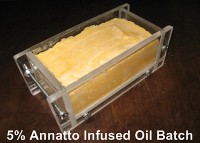
Below is a picture of my annatto seed batch that had 15% annatto seed infused oil. It ended up being a very nice medium orange color.
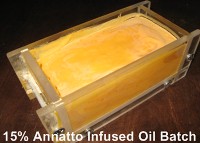
Next is a picture of my annatto seed batch that had 35% annatto seed infused oil. I did this test to see if a high percentage such as 35% would “bleed” and give me colored suds. It did!
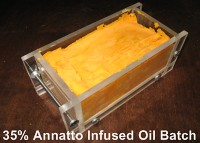
Here’s a picture of me washing my hands with the 35% annatto seed infused oil soap. As you can see, the color bled and the suds are orange. Not what I was looking for!
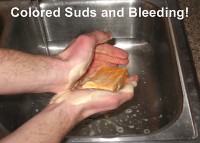
Next is a picture of a batch that I colored using annatto seeds soaked in my lye solution. Awesome color! For some reason, this one almost looked like a neon yellow. I soaked 2 teaspoons of annatto seeds in my lye solution for approximately 3.5 hours. Keep in mind that this was only a two pound batch, so if you are making a bigger batch, you will need to add more seeds if trying to get a similar hue! The seeds of course were drained out using a stainless steel strainer before using the lye solution in my batch.
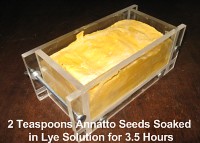
Next is a picture of a batch that I colored using ground up annatto seeds. I ground up 2 teaspoons of seeds in my coffee grinder and added them at trace to the two pound batch. The final soap was yellow, but had a ton of speckles in it from the seeds. It didn’t look bad if that is the look you are trying to go for! Because of the seeds, it may also be somewhat scratchy.
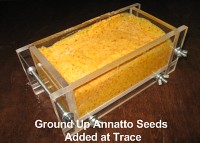
I also looked at how my superfat percentage would affect the color. With some natural colorants, a higher or lower superfat will change the final hue. Not sure why exactly this is, but I was thinking maybe it had something to do with PH levels? If anyone knows, please feel free to chime in! For annatto seeds, it appears that superfat percentages don’t really affect the final color of the soap. If anything, the 12% superfat may have been a bit darker in color then the 5% superfat… but it was barely noticeable.
Here’s the picture of the 5% superfat soap:
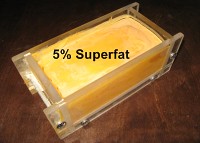
Here’s a picture of the 12% superfat soap:
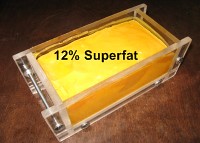
Finally, I looked at the Gel phase and how that would affect the color. For annatto seeds, the gel phase made the color much darker! I did the test using the 15% infused oil batch. One I forced to gel and the other I did not. The gelled batch was almost as dark as the 35% annatto infused oil batch that had the “bleeding” issue and colored suds! Gelling seems to be a great method of achieving that darker color without having issues like bleeding or colored bubbles.
Here’s a picture of the gelled batch:
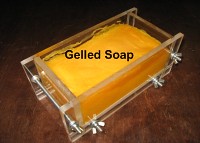
Here’s a picture of the non-gelled batch:
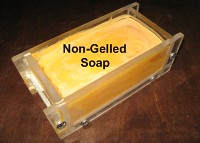
These two batches above were literally identical… same recipe... same annatto seed oil proportions. Only difference was one went through gel and the other did not. It’s really quite amazing how much darker the gelled soap was!
-------------------------------------------------
I hope you all enjoyed these annatto seed soap pictures and notes about using annatto seeds as a natural colorant! Let me know what you all think.
Like I said, I am working hard to build this natural colorant database, so hopefully I will have more findings to share with you all for the next colorant, which will hopefully be coming out soon! Hahaha… it will probably take a LONG TIME for this thing to be completed as I can name more then 20 natural colorants off the top of my head! It should be a ton of fun to create though!
Until next time....
Sincerely,
Steve P. Czapla
I’m working very hard on creating a natural soap colorant database for myself and my fellow soapers. I will be making a ton of batches in the next few months experimenting with the various natural colorants and recording my results to share with you all.
I am looking at how the percentage of infused oil in my batch will affect the color, how adding the botanical to the lye solution will affect the color, how adding the powdered botanical to the soap will affect the color, how my superfat percentage will affect the color, and how the gel phase will affect the color. Yeah… It’s very thorough! Hopefully though, it will be a helpful tool for soap makers who are interested in using natural colorants but don’t know where to start.
I will be taking a ton of pictures and notes and figured I’d might as well share them with you all. I hope it helps in some way!
I just finished the annatto seed portion of the database. Below are the pictures from that tutorial. Enjoy!
The first photo is a picture of all the shades I achieved with annatto seeds using all the different methods. As you can see, you can get a lot of different hues all the way from a bright yellow to dark orange using annatto seeds. I thought this was pretty cool to see them all side by side.

My infusion rate was 4 teaspoons annatto seeds per 8 ounces of olive oil. I created this infusion by placing the seeds and oil in my crock-pot that was set at a low heat and then allowed this combination to simmer for exactly two hours. By the end of the infusion, the oil appeared to have a deep red color, however, the infused oil still produced a strong yellow color when dropped onto a piece of white paper towel.
Here’s a before and after picture of my infusion. You can really see just how much the color changed:

--------------------------------------------------------

Side by side, you can really see the color difference between the infused oil and non-infused oil. Annatto infused oil is really very pretty!

Here’s another pic… This one is of me pouring the infused oil into my soap batch. I just thought this was a pretty cool shot and kind of highlights the beauty of the annatto infused oil. Again, it looks red at first, but even this batch quickly turned yellow/orange once the infused oil was mixed in thoroughly.

Now for some pics of the final annatto seed soaps…
Below is a picture of my soap batch that had 5% annatto seed infused oil. What does this mean exactly? Let’s say your batch uses 45 ounces of oils total… 5% of 45 ounces would be 2.25 ounces. So, 2.25 ounces of oil in your recipe would be annatto infused oil! At this percentage, the color ended up being a pale lemon yellow.

Below is a picture of my annatto seed batch that had 15% annatto seed infused oil. It ended up being a very nice medium orange color.

Next is a picture of my annatto seed batch that had 35% annatto seed infused oil. I did this test to see if a high percentage such as 35% would “bleed” and give me colored suds. It did!

Here’s a picture of me washing my hands with the 35% annatto seed infused oil soap. As you can see, the color bled and the suds are orange. Not what I was looking for!

Next is a picture of a batch that I colored using annatto seeds soaked in my lye solution. Awesome color! For some reason, this one almost looked like a neon yellow. I soaked 2 teaspoons of annatto seeds in my lye solution for approximately 3.5 hours. Keep in mind that this was only a two pound batch, so if you are making a bigger batch, you will need to add more seeds if trying to get a similar hue! The seeds of course were drained out using a stainless steel strainer before using the lye solution in my batch.

Next is a picture of a batch that I colored using ground up annatto seeds. I ground up 2 teaspoons of seeds in my coffee grinder and added them at trace to the two pound batch. The final soap was yellow, but had a ton of speckles in it from the seeds. It didn’t look bad if that is the look you are trying to go for! Because of the seeds, it may also be somewhat scratchy.

I also looked at how my superfat percentage would affect the color. With some natural colorants, a higher or lower superfat will change the final hue. Not sure why exactly this is, but I was thinking maybe it had something to do with PH levels? If anyone knows, please feel free to chime in! For annatto seeds, it appears that superfat percentages don’t really affect the final color of the soap. If anything, the 12% superfat may have been a bit darker in color then the 5% superfat… but it was barely noticeable.
Here’s the picture of the 5% superfat soap:

Here’s a picture of the 12% superfat soap:

Finally, I looked at the Gel phase and how that would affect the color. For annatto seeds, the gel phase made the color much darker! I did the test using the 15% infused oil batch. One I forced to gel and the other I did not. The gelled batch was almost as dark as the 35% annatto infused oil batch that had the “bleeding” issue and colored suds! Gelling seems to be a great method of achieving that darker color without having issues like bleeding or colored bubbles.
Here’s a picture of the gelled batch:

Here’s a picture of the non-gelled batch:

These two batches above were literally identical… same recipe... same annatto seed oil proportions. Only difference was one went through gel and the other did not. It’s really quite amazing how much darker the gelled soap was!
-------------------------------------------------
I hope you all enjoyed these annatto seed soap pictures and notes about using annatto seeds as a natural colorant! Let me know what you all think.
Like I said, I am working hard to build this natural colorant database, so hopefully I will have more findings to share with you all for the next colorant, which will hopefully be coming out soon! Hahaha… it will probably take a LONG TIME for this thing to be completed as I can name more then 20 natural colorants off the top of my head! It should be a ton of fun to create though!
Until next time....
Sincerely,
Steve P. Czapla









































